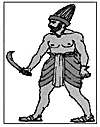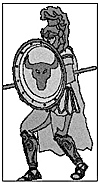(Note: The rules used to fight the battle were the author's own "Lance and Spear." The author played the part of the Assyrian Sennacherrib, and Preston Russ, Alexander.)
 This is a fictional clash of armies that can only be done from the perspective of history. Few people really appreciate the Assyrian empire. This is a kingdom that spanned several hundred years and knew the greatness of empire and the pain of one on the wane. Its strength and weakness was its king. The entire empire was built for the power and wealth of one man -- almost as if empire was the family business. The business of Assyria was stealing other people's wealth. Some sons were better at it then others. The whole country was one massive war industry. When there was a good king to lead the people, they were an unstoppable force.
This is a fictional clash of armies that can only be done from the perspective of history. Few people really appreciate the Assyrian empire. This is a kingdom that spanned several hundred years and knew the greatness of empire and the pain of one on the wane. Its strength and weakness was its king. The entire empire was built for the power and wealth of one man -- almost as if empire was the family business. The business of Assyria was stealing other people's wealth. Some sons were better at it then others. The whole country was one massive war industry. When there was a good king to lead the people, they were an unstoppable force.
The key to this force were the flexibility of their foot troops. In one campaign, they operated as both close order spear, resisting cavalry charges, and open order mountain troops moving through the worst of terrain. Thus, there was no choice but to test this army against one of the best armies ever fielded, Alexander and his veteran troops from Macedonia. It is set up with Alexander attacking and Assyria defending. The Assyrian army is a very late one, but one that I think is the best. It is led by the brilliant and successful general, Sennacherrib.
The Assyrians prefer some defensive terrain, but also need open areas for their horse bow and chariots to be effective. Alexander needs more open ground for his fast moving strikes, but also can use some defensive points to anchor his flanks. So, the field is doted with a few hills, but none of real important value. There are also small patches of woods and rough, but again none of real value. A road crosses the battlefield in front of the Assyrian lines and is assumed to be the road that leads into the Assyrian heart lands. Alexander will need to defeat the Assyrians pretty soundly, while all the Assyrians need to do is stand their ground and drive off the intruder (destroying Alexander's army, of course, is always the best result).
Deployment
The Assyrians set up in three lines, with militia troops in front. Don't let the name fool you. They are good troops. Mostly raised from cities around the empire, they are commonly used on major campaigns outside the empire to supplement the normal troops. They are also employed as scouts and like rough terrain. However, firepower is their greatest asset to the empire. They tended to be the best archers in the army. Reserve spears make up the next line. These are the normal troops called up and used when the empire is on the march. In this group is found the typical Assyrian soldier. Trained and equipped by the empire, they were very similar to our National Guard today. At periodic times, they were to receive training, and it was expected that they would fill the ranks when called.
Some foreign troops also served at this level. Assyrian kings deported people from their home lands and gave them new lands to live in. It was expected that they to would take part in the work of the empire. Creating the last line was the king and his chariots, cavalry and regular and special foreign troops. These were the troops that made up what would be called a standing army. Here any special foreign formations that the king thought useful were placed -- things such as axe troops and special light Chaldean forces. At this time, straight heavy horse cavalry were just beginning to show up. The most common heavy force were chariots and the Assyrians made good use of them. These were fighting platforms of a very sophisticated nature. By some accounts, there was also some heavy cavalry, but its use is uncertain. The most common horse troop is the horse bow and the Hunnic type light horse used for centuries in the open areas of Asia. In this battle, only chariots and the last two forms of cavalry are used.
Alexander's army
Alexander's army is a late-period army, with things like elephants and other troops he had found effective as he rolled over his opponents. In the front of his army are elephants and light skirmishers. These forces are to break up and pin the larger forces of the Assyrian army, so that Alexander can use his typical breakthrough maneuver. Behind them, a line is formed moving from right to left starting with the Thessalian cavalry. It is the Companions next in line, though, that are the real problem. These small, but deadly, groups of cavalry can do terrible damage to any enemy not ready to deal with them, especially when led by Alexander. The Assyrian plan is to slow them up with spear troops forming a shield wall and shoot them from the flanks. Next, are the Phalangites and Hypastists. These powerful pike-armed troops are nearly unstoppable. Then come the light peltasts who cover the flanks of the Phalangites. Behind the peltasts are units of Greek spear, kept in reserve to protect against any breakthroughs.
 The battle starts out fast. Alexander's light cavalry and horse bow begin with an assault on the Assyrian left flank. Using their speed to minimize losses in swirling, desperate fight, they surround and destroy a unit of slingers in the third rank. This opens a hole for the Companions to exploit. At the same time, Alexander has his Indian elephants act as a battering ram to break through the first Assyrian line made up of archers and light troops. The Assyrians hoped the archers would be able to deal with the elephants. To some extent, they did. But pinned as they were, they were not able to stop the Companions as they raced past into the second line.
The battle starts out fast. Alexander's light cavalry and horse bow begin with an assault on the Assyrian left flank. Using their speed to minimize losses in swirling, desperate fight, they surround and destroy a unit of slingers in the third rank. This opens a hole for the Companions to exploit. At the same time, Alexander has his Indian elephants act as a battering ram to break through the first Assyrian line made up of archers and light troops. The Assyrians hoped the archers would be able to deal with the elephants. To some extent, they did. But pinned as they were, they were not able to stop the Companions as they raced past into the second line.
The Assyrians responded with an assault on Alexander's right, attacking the peltasts using their horse bow and Chaldean clan troops. The combination of speed and hitting power was to much for the lightly-armed troops, and they were quickly forced back. Alexander tried to cover this assault by using his Greek reserve, but the speed of the fight was too fast for the slow-moving Greek spearmen and they were soon overwhelmed, too. Back on the other side, the Companions now began to exploit the hole on the Assyrian left, trying to roll up the Assyrian line. The shield wall in the second line was no match for the speed of the Companions. The archers that anchored the left of the Assyrian second line did punish the Companion cavalry, but they could not stop such a brutal and swift assault. Spear units tried to turn to face the oncoming threat, but once the shield wall was broken, the cavalry were able, although at a price, to overrun and destroy each unit.
The Final Blows
On the right side of the Assyrian line, things began to go bad, too. Pushing forward to follow up their success, the horse bow over extended themselves and soon fell prey to the more powerful Thessalian cavalry. The Assyrian cavalry was forced to fall back, leaving the Chaldean troops to fight on their own. Much blood was traded, but finally the Chaldeans could hold out no longer and fled the field. Their fight did tie up the few forces remaining on the Macedonian left, which would prove important later.
The fighting slowed a little now, as the Companions and other forces were beginning to feel the effects of the casualties they were taking. With the best Assyrian troops still fresh in the third line, it was now time of the Phalangites and Hypastists to do their work. They were facing the Assyrian foot guard and neo-Hittite axe men -- both of which were equal to anything Alexander had. At first, the Assyrian general considered a heavy chariot charge against the beat-up Companions, but it was clear they were still too fast and dangerous. Using what was left of his horse bow and Hunnic cavalry, he decided to take advantage of the open right flank that the trapped Chaldeans gave him and moved to flee the field. With his Phalangites and Hypastists still occupied, and not having any thing left with great enough strength to stop the Assyrians from getting away, Alexander had to allow them to escape. The battle ended there and was declared a marginal victory for Alexander. But with the losses he suffered, it would be some time before he could give battle.
On the whole, the Assyrians gave a good fight, and Alexander used his troops with skill. With a little luck, the battle could have gone the other way. It cost a lot to stop the elephants, but the Companions used up their strength too quickly and had nothing to give in the last push. Alexander's pike are fearsome troops and only really good troops can stand against them. However, the Assyrian foot guard did well and the axe men "gave as well as they got" also. The shield wall failed, but not much was expected of it under the conditions anyway. The Assyrian army of this period seems a good choice to face Alexander.
Back to The Herald 34 Table of Contents
Back to The Herald List of Issues
Back to MagWeb Master Magazine List
© Copyright 2000 by HMGS-GL.
This article appears in MagWeb (Magazine Web) on the Internet World Wide Web. Other military history articles and gaming articles are available at http://www.magweb.com